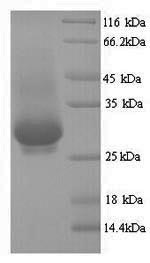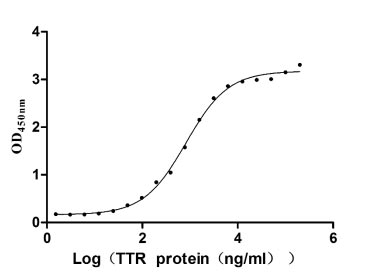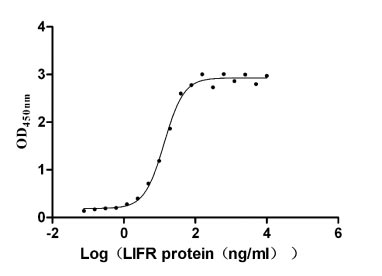Recombinant Rotavirus A Outer capsid protein VP4, partial
In Stock-
货号:CSB-YP320838ROH
-
规格:¥2616
-
图片:
-
其他:
产品详情
-
纯度:Greater than 90% as determined by SDS-PAGE.
-
基因名:N/A
-
Uniprot No.:
-
别名:; Outer capsid protein VP4; Hemagglutinin) [Cleaved into: Outer capsid protein VP8*; Outer capsid protein VP5*]
-
种属:Rotavirus A (strain Human/United Kingdom/ST3/1975 G4-P2A[6]-I1-R1-C1-M1-A1-N1-T1-E1-H1) (RV-A) (Rotavirus A (strain St. Thomas 3))
-
蛋白长度:Partial
-
来源:Yeast
-
分子量:28.3kDa
-
表达区域:247-479aa
-
氨基酸序列AQVSEDIIISKTSLWKEMQYNRDIIIRFKFNNSIIKLGGLGYKWSEISFKAANYQYNYLRDGEQVTAHTTCSVNGVNNFSYNGGLLPTHFSISRYEVIKENSYVYVDYWDDSQAFRNMVYVRSLAANLNSVKCSGGNYNFQMPVGAWPVMSGGAVSLHFAGVTLSTQFTDFVSLNSLRFRFSLTVEEPPFSILRTRVSGLYGLPASNPNSGHEYYEIAGRFSLISLVPSNDDY
Note: The complete sequence including tag sequence, target protein sequence and linker sequence could be provided upon request. -
蛋白标签:N-terminal 6xHis-tagged
-
产品提供形式:Liquid or Lyophilized powder
Note: We will preferentially ship the format that we have in stock, however, if you have any special requirement for the format, please remark your requirement when placing the order, we will prepare according to your demand. -
缓冲液:Tris-based buffer,50% glycerol
-
储存条件:Store at -20°C/-80°C upon receipt, aliquoting is necessary for mutiple use. Avoid repeated freeze-thaw cycles.
-
保质期:The shelf life is related to many factors, storage state, buffer ingredients, storage temperature and the stability of the protein itself.
Generally, the shelf life of liquid form is 6 months at -20°C/-80°C. The shelf life of lyophilized form is 12 months at -20°C/-80°C. -
货期:3-7 business days
-
注意事项:Repeated freezing and thawing is not recommended. Store working aliquots at 4°C for up to one week.
-
Datasheet & COA:Please contact us to get it.
相关产品
问答及客户评论
The strain for this is listed as Rotavirus A, and we want to know if this also wA strain rotarix.
Rotavirus is the most common cause of diarrhoeal disease among infants and young children.[1] It is a genus of double-stranded RNA viruses in the family Reoviridae.
Nearly every child in the world is infected with rotavirus at least once by the age of five.[2] Immunity develops with each infection, so subsequent infections are less severe; adults are rarely affected.[3] There are nine species of this virus, referred to as A, B, C, D, E, F, G, H and I. Rotavirus A, the most common species, causes more than 90% of rotavirus infections in human.
靶点详情
-
功能:Spike-forming protein that mediates virion attachment to the host epithelial cell receptors and plays a major role in cell penetration, determination of host range restriction and virulence. Rotavirus attachment and entry into the host cell probably involves multiple sequential contacts between the outer capsid proteins VP4 and VP7, and the cell receptors. It is subsequently lost, together with VP7, following virus entry into the host cell. Following entry into the host cell, low intracellular or intravesicular Ca(2+) concentration probably causes the calcium-stabilized VP7 trimers to dissociate from the virion. This step is probably necessary for the membrane-disrupting entry step and the release of VP4, which is locked onto the virion by VP7. During the virus exit from the host cell, VP4 seems to be required to target the newly formed virions to the host cell lipid rafts.; Forms the spike 'foot' and 'body' and acts as a membrane permeabilization protein that mediates release of viral particles from endosomal compartments into the cytoplasm. During entry, the part of VP5* that protrudes from the virus folds back on itself and reorganizes from a local dimer to a trimer. This reorganization may be linked to membrane penetration by exposing VP5* hydrophobic region. In integrin-dependent strains, VP5* targets the integrin heterodimer ITGA2/ITGB1 for cell attachment.; Forms the head of the spikes and mediates the recognition of specific host cell surface glycans. It is the viral hemagglutinin and an important target of neutralizing antibodies. In sialic acid-dependent strains, VP8* binds to host cell sialic acid, most probably a ganglioside, providing the initial contact. In some other strains, VP8* mediates the attachment to histo-blood group antigens (HBGAs) for viral entry.
-
亚细胞定位:[Outer capsid protein VP4]: Virion. Host rough endoplasmic reticulum. Host cell membrane. Host cytoplasm, host cytoskeleton. Host endoplasmic reticulum-Golgi intermediate compartment.; [Outer capsid protein VP8*]: Virion.; [Outer capsid protein VP5*]: Virion.
-
蛋白家族:Rotavirus VP4 family
Most popular with customers
-
Recombinant Human Retinol-binding protein 4 (RBP4) (Active)
Express system: Mammalian cell
Species: Homo sapiens (Human)
-
Recombinant Human Leukemia inhibitory factor receptor (LIFR), partial (Active)
Express system: Mammalian cell
Species: Homo sapiens (Human)
-
Recombinant Human Somatostatin receptor type 2 (SSTR2)-VLPs (Active)
Express system: Mammalian cell
Species: Homo sapiens (Human)
-
Recombinant Macaca fascicularis lymphocyte antigen 6 family member G6D (LY6G6D) (Active)
Express system: Yeast
Species: Macaca fascicularis (Crab-eating macaque) (Cynomolgus monkey)
-
Recombinant Human Myosin regulatory light polypeptide 9 (MYL9) (Active)
Express system: Yeast
Species: Homo sapiens (Human)
-
Recombinant Human Kidney-associated antigen 1(KAAG1) (Active)
Express system: Baculovirus
Species: Homo sapiens (Human)
-
Express system: Mammalian cell
Species: Homo sapiens (Human)




















